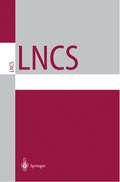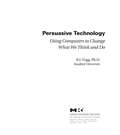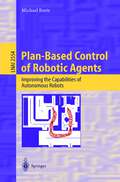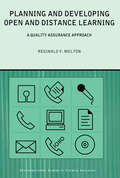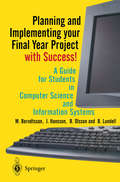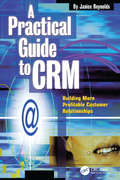- Table View
- List View
Performance Evaluation of Complex Systems: Performance 2002. Tutorial Lectures (Lecture Notes in Computer Science #2459)
by Maria Carla Calzarossa Salvatore TucciPerspectives on School Algebra (Mathematics Education Library #22)
by Alan Bell Romulo Lins Teresa Rojano Rosamund SutherlandThis book confronts the issue of how young people can find a way into the world of algebra. It represents multiple perspectives which include an analysis of situations in which algebra is an efficient problem-solving tool, the use of computer-based technologies, and a consideration of the historical evolution of algebra. The book emphasizes the situated nature of algebraic activity as opposed to being concerned with identifying students' conceptions in isolation from problem-solving activity.
Persuasive Technology: Using Computers to Change What We Think and Do (Interactive Technologies)
by B.J. FoggCan computers change what you think and do? Can they motivate you to stop smoking, persuade you to buy insurance, or convince you to join the Army? "Yes, they can," says Dr. B.J. Fogg, director of the Persuasive Technology Lab at Stanford University. Fogg has coined the phrase "Captology"(an acronym for computers as persuasive technologies) to capture the domain of research, design, and applications of persuasive computers.In this thought-provoking book, based on nine years of research in captology, Dr. Fogg reveals how Web sites, software applications, and mobile devices can be used to change people's attitudes and behavior. Technology designers, marketers, researchers, consumers—anyone who wants to leverage or simply understand the persuasive power of interactive technology—will appreciate the compelling insights and illuminating examples found inside. Persuasive technology can be controversial—and it should be. Who will wield this power of digital influence? And to what end? Now is the time to survey the issues and explore the principles of persuasive technology, and B.J. Fogg has written this book to be your guide.* Filled with key term definitions in persuasive computing*Provides frameworks for understanding this domain*Describes real examples of persuasive technologies
Pervasive Computing: First International Conference, Pervasive 2002, Zürich, Switzerland, August 26-28, 2002. Proceedings (Lecture Notes in Computer Science #2414)
by Friedemann Mattern Mahmoud NaghshinehThis volume contains the proceedings of Pervasive 2002, the ?rst in a series of international conferences on Pervasive Computing. The conference took place at ETH Zurich from August 26to 28, 2002. Its objective was to present, discuss, and explore the latest technical developments in the emerging ?eld of pervasive computing, as well as potential future directions. Pervasive Computing is a cross-disciplinary area that extends the appli- tion of computing to diverse usage models. It covers a broad set of research topics such as low power, integrated technologies, embedded systems, mobile - vices, wireless and mobile networking, middleware, applications, user interfaces, security, and privacy. The great amount of interest we are witnessing in Per- sive Computing is driven by relentless progress in basic information technologies such as microprocessors, memory chips, integrated sensors, storage devices, and wireless communication systems that continue to enable ever smaller, lighter, and faster systems. Such systems are also becoming a?ordable due to their high integration and mass production, paving the way for their adoption.
Pflegeinformatik
by Kathryn J. Hannah Marion J. Ball Margaret J.A. EdwardsWissen Sie, wie Ihr Stationscomputer funktioniert oder wie ein Netzwerk aufgebaut ist? Hier finden Sie verständliche Antworten auf eine Vielzahl spannender Fragen aus dem Gebiet der Pflegeinformatik. - Pflegedokumentation, Pflegediagnosen, ICNP- Leistungserfassung in der Akut- und Langzeitpflege- Elektronisch gestützte Aus- und Weiterbildung Verzeichnisse von Datenbanken, ein Glossar wichtiger Fachbegriffe sowie ein Adressenverzeichnis schlagen die Brücke zur Praxis.
Phase-Locked Loops for Wireless Communications: Digital, Analog and Optical Implementations
by Donald R. StephensPhase-Locked Loops for Wireless Communications: Digitial, Analog and Optical Implementations, Second Edition presents a complete tutorial of phase-locked loops from analog implementations to digital and optical designs. The text establishes a thorough foundation of continuous-time analysis techniques and maintains a consistent notation as discrete-time and non-uniform sampling are presented. New to this edition is a complete treatment of charge pumps and the complementary sequential phase detector. Another important change is the increased use of MATLAB®, implemented to provide more familiar graphics and reader-derived phase-locked loop simulation. Frequency synthesizers and digital divider analysis/techniques have been added to this second edition. Perhaps most distinctive is the chapter on optical phase-locked loops that begins with sections discussing components such as lasers and photodetectors and finishing with homodyne and heterodyne loops. Starting with a historical overview, presenting analog, digital, and optical PLLs, discussing phase noise analysis, and including circuits/algorithms for data synchronization, this volume contains new techniques being used in this field. Highlights of the Second Edition: Development of phase-locked loops from analog to digital and optical, with consistent notation throughout; Expanded coverage of the loop filters used to design second and third order PLLs; Design examples on delay-locked loops used to synchronize circuits on CPUs and ASICS; New material on digital dividers that dominate a frequency synthesizer's noise floor. Techniques to analytically estimate the phase noise of a divider; Presentation of optical phase-locked loops with primers on the optical components and fundamentals of optical mixing; Section on automatic frequency control to provide frequency-locking of the lasers instead of phase-locking; Presentation of charge pumps, counters, and delay-locked loops. The Second Edition includes the essential topics needed by wireless, optics, and the traditional phase-locked loop specialists to design circuits and software algorithms. All of the material has been updated throughout the book.
Photoshop 7 and Illustrator 10: Create Great Advanced Graphics
by Vicki Loader Dave Cross Barry Huggins Ian TindaleThis book will show you how to combine the power of Photoshop 7 and Illustrator 10 to take your creative and production skills to new heights. Find out the best way to use them in tandem, with a seamless workflow, for stunning results in your print and web output. The book looks at how the programs work together to help you create great graphics with practical demonstrations of projects you are likely to encounter in your work. You'll learn advanced techniques for working with layer blending modes, the latest tools and new file formats such as SVG, along with color management, animation, printing, web-publishing, and integration with other programs. This book is not for Photoshop and Illustator novices—it's called 'Advanced' because it aims to take your basic skills to the next level and teach you how to create the finest graphics you find in the world around you. The book looks at how the programs can serve each other and you: Adobe has worked hard to make these two applications function more efficiently together—this book will help you to reap the rewards of their labor. The aim of this book is to show how Photoshop 7 and illustrator 10 can work together as part of a team; this means looking at their strengths and weaknesses and how they compliment one another. Part 1 is shorter than Part 2 and contains an analysis of each application; how each one performs certain tasks and where the crossover lies. Many functions can be acheived in both and there is a certain amount of personal choice involved—we evaluate the benefits of each one and which may be suited to certain tasks: we want you to find the right balance to maintain a long and happy marriage! In Part 2, we look at the practical applications of each one through a series of projects that detail step-by-step how they may be used in conjunction with each other. The tutorials are backed up with theory and additional information to help you make an informed choice when deciding the workflow that fits you best. We hope to help you make the best use of your skills and talents, so you can go further and achieve more.
Photoshop 7 Professional Photographic Techniques
by Shahid Shah Gavin Cromhout Nyree Costello Janee AronoffFully illustrated in color throughout, the text is organized into a series of examples that provides a comprehensive guide to image manipulation on Photoshop 7 -- everything from the glamour of magazine retouching, through restoration work to the nitty-gritty of color reproduction.
Photoshop 7 Trade Secrets
by Colin Smith Dave Cross Janee Aronoff Gavin CromhoutHow do you get the best out of Photoshop? It's a combination of knowing what you want and knowing how to do it properly: a mixture of creativity and acumen. As you learn more, you make fewer mistakes, your workflow becomes faster, and you have more time to explore creative possibilities. This book is dedicated to showing you the tricks of the trade, to sharing the insider's knowledge which will speed up your work, and to improving your understanding of Photoshop as a tool. The book is divided into eight chapters, in the first three we look at ways of improving your efficiency, good selection techniques, and how to use layers effectively. In the next three chapters we look at practical applications of Photoshop for retouching and correction, Web graphics and special effects. The final two chapters look at the practicalities of Photoshop's configuration and hardware. Throughout the book, we cover the new features of Photoshop 7, so if you're not yet up to speed with the latest version, we'll show you the way. You've mastered the basics of Photoshop and you're ready to move on to the next level - this book is jam-packed with the hints, tips, and advice from four Photoshop experts that you need to take you there. To get the most information out of each of the authors that we possibly could, we used a collaborative method of writing. Each of the four authors chose two subject areas to be the main writer on, and once they had finished writing the sections, they were passed on to the other three authors for them to add their own tips and tricks to. All these parts then went out to review, and the reviewers (themselves Photoshop users) added their tips to the tip-tank. All of these tips then came together in editorial, where they were ordered and polished. In this way, we hoped to maximize the amount of insightful and essential information, and to give you the greatest benefit.
Photoshop Elements 2 Most Wanted
by Pete Walsh Francine Spiegel Janee AronoffAll the most common and popular uses of Adobe Photoshop Elements 2 have been brought together in one volume. Each section provides a useful guide to techniques, a summary of the tools used and several step-by-step projects to clearly demonstrate each effect. There's also a wealth of tips and tricks to help you get the most out of this latest version of Elements. We've searched forums, looked in magazines, spoken to users and asked the experts at Adobe, to find out exactly what are the Most Wanted ways to use this versatile application. Everyone from ethusiastic amateurs, hobbyist photographers and business users will find invaluable advice about using this amazing image manipulation tool. Whether you are new to digital imaging or have been experimenting for several years, you'll find a wealth of information that you can immediately start putting into practice. Topics covered include: restoring and retouching photos, maipulating and merging images, creating your own artwork, sharing your pictures with others and even creating your own of web pages. On the CD that accompanies the book are all the source files to recreate the examples shown in the book, and a fully functional tryout of the latest version of the software.
Photoshop Face to Face
by Katy Freer Francine Spiegel Gavin Cromhout Adrian Luna Nathan Flood Josh Fallon Douglas Mullen Jim Hannah James WidegrenIf we were to say Marilyn to you, what would you be thinking? Monroe? Manson? Well, you would be thinking about the most inspired use of facial imagery. Anybody in advertising will tell you that the most effective sales tool around is the face. A face can sell you anything. Any product, any idea. And the most striking faces become icons in their own right. With Adobe Photoshop, we can see the possibilities for facial stylization explode. This book looks at how to develop an image to get it right, and how to make these mugshots genuinely memorable. Some of the most exciting designers around have gathered to work their magic on this tightly focused canvas, working from a number of different starting points. Whether it's a perfect gloss you're after, or an abstract form of iconography, Photoshop has a collection of subtle and powerful tricks up its sleeve, and this book coaxes them into the open. This is a full color inspirations title, aimed at showing professionals and home users alike how to access the multiplicity of techniques available in Adobe Photoshop. By using such a familiar model as the human face, the effectiveness and originality of these techniques is thrown into sharp relief. The book employs versions of Photoshop up to the release of version 7, although the techniques shown will be compatible with previous releases of the software. Each chapter contains multiple examples of how to treat a face in Photoshop, and an in-depth explanation of technique from the designer.
Plan-Based Control of Robotic Agents: Improving the Capabilities of Autonomous Robots (Lecture Notes in Computer Science #2554)
by Michael BeetzRobotic agents, such as autonomous office couriers or robot tourguides, must be both reliable and efficient. Thus, they have to flexibly interleave their tasks, exploit opportunities, quickly plan their course of action, and, if necessary, revise their intended activities. This book makes three major contributions to improving the capabilities of robotic agents: - first, a plan representation method is introduced which allows for specifying flexible and reliable behavior - second, probabilistic hybrid action models are presented as a realistic causal model for predicting the behavior generated by modern concurrent percept-driven robot plans - third, the system XFRMLEARN capable of learning structured symbolic navigation plans is described in detail.
Planning and Developing Open and Distance Learning: A Framework for Quality (Routledge Studies in Distance Education)
by Reginald F. MeltonThis book is aimed at those who are considering, or just starting to plan open and distance learning courses. It offers practical advice on how to find your students, expand your audience and become cost-effective without compromising quality. The main areas covered are: basic principles and different approaches to ODL different types of self-study materials, media, and student support from your institution building quality assurance into the development process With a wide range of practical, tried-and-tested examples and case studies, the book provides a complete guide to setting up ODL courses.
Planning and Developing Open and Distance Learning: A Framework for Quality (Routledge Studies in Distance Education)
by Reginald F. MeltonThis book is aimed at those who are considering, or just starting to plan open and distance learning courses. It offers practical advice on how to find your students, expand your audience and become cost-effective without compromising quality. The main areas covered are: basic principles and different approaches to ODL different types of self-study materials, media, and student support from your institution building quality assurance into the development process With a wide range of practical, tried-and-tested examples and case studies, the book provides a complete guide to setting up ODL courses.
Planning and Implementing your Final Year Project — with Success!: A Guide for Students in Computer Science and Information Systems
by Mikael Berndtsson Jörgen Hansson B. Olsson Björn LundellWritten in concise language this book is for any student who is about to undertake a final year undergraduate or MSc project. It takes them step-by-step through all the important stages of the process, from initial planning to completion. It tells them everything they need to know about key issues such as: How to formulate a suitable problem, Which research method to use, Developing an appropriate structure for the written report, Project focus, and Quality assurance. The book aims to demystify the whole process, making it invaluable for any MSc student.
Positive 1D and 2D Systems (Communications and Control Engineering)
by Tadeusz KaczorekMoving on from earlier stochastic and robust control paradigms, this book introduces the reader to the fundamentals of probabilistic methods in the analysis and design of uncertain systems. It significantly reduces the computational cost of high-quality control and the complexity of the algorithms involved.
Power Aware Computing (Series in Computer Science)
by Robert Graybill Rami MelhemWith the advent of portable and autonomous computing systems, power con sumption has emerged as a focal point in many research projects, commercial systems and DoD platforms. One current research initiative, which drew much attention to this area, is the Power Aware Computing and Communications (PAC/C) program sponsored by DARPA. Many of the chapters in this book include results from work that have been supported by the PACIC program. The performance of computer systems has been tremendously improving while the size and weight of such systems has been constantly shrinking. The capacities of batteries relative to their sizes and weights has been also improv ing but at a rate which is much slower than the rate of improvement in computer performance and the rate of shrinking in computer sizes. The relation between the power consumption of a computer system and it performance and size is a complex one which is very much dependent on the specific system and the technology used to build that system. We do not need a complex argument, however, to be convinced that energy and power, which is the rate of energy consumption, are becoming critical components in computer systems in gen eral, and portable and autonomous systems, in particular. Most of the early research on power consumption in computer systems ad dressed the issue of minimizing power in a given platform, which usually translates into minimizing energy consumption, and thus, longer battery life.
Power Plant Surveillance and Diagnostics: Applied Research with Artificial Intelligence (Power Systems)
by Da Ruan Paolo F. FantoniEdited book reporting recent results in AI research in power plant surveillance and diagnostics. High quality and applicability of the contributions through a thorough peer-reviewing process. Condition Monitoring and Early Fault Detection provide for better efficiency of energy systems, at lower costs. Inhalt Featured Topics: Analysis of important issues relating to specification, development and use of systems for computer-assisted plant surveillance and diagnosis.- Empirical and analytical methods for on-line calibration monitoring and data reconciliation.- Noise analysis methods for early fault detection, condition monitoring, leak detection and loose part monitoring.- Predictive maintenance and condition monitoring techniques.- Empirical and analytical methods for fault detection and recognition.
Power SAS: A Survival Guide
by Darlynn LaflerLafler's book provides SAS users (Version 8.2) with a wonderful collection of tips, undocumented or hard-to-find tidbits of information, and other useful techniques in more than 1,000 entries.
A Practical Approach to Software Quality
by Gerard O'ReganA brief but comprehensive introduction to the field and pragmatic guidance on the implementation of a sound quality system in the organization. It provides an enhanced knowledge of software inspections, metrics, process involvement, assessment of organization, problem solving, customer satisfaction surveys, the CMM, SPICE, and formal methods. Sample material on software inspections, metrics, and customer satisfaction can be adapted by readers to their respective organizations. In addition, readers will gain a detailed understanding of the principles of software quality management and software process improvement. Concepts can then be readily applied to assist improvement programs within organizations.
Practical Aspects of Declarative Languages: 4th International Symposium, PADL 2002, Portland, OR, USA, January 19-20, 2002. Proceedings (Lecture Notes in Computer Science #2257)
by Shriram Krishnamurthi C. R. RamakrishnanDeclarative languages build on sound theoretical bases to provide attractive frameworks for application development. These languages have been succe- fully applied to a wide variety of real-world situations including database m- agement, active networks, software engineering, and decision-support systems. New developments in theory and implementation expose fresh opportunities. At the same time, the application of declarative languages to novel problems raises numerous interesting research issues. These well-known questions include scalability, language extensions for application deployment, and programming environments. Thus, applications drive the progress in the theory and imp- mentation of declarative systems, and in turn bene?t from this progress. The International Symposium on Practical Applications of Declarative L- guages (PADL) provides a forum for researchers, practitioners, and implementors of declarative languages to exchange ideas on current and novel application - eas and on the requirements for e?ective use of declarative systems. The fourth PADL symposium was held in Portland, Oregon, on January 19 and 20, 2002.
Practical Aspects of Knowledge Management: 4th International Conference, PAKM 2002, Vienna, Austria, December 2-3, 2002, Proceedings (Lecture Notes in Computer Science #2569)
by Dimitris Karagiannis Ulrich ReimerThis book contains the papers presented at the 4th International Conference on Practical Aspects of Knowledge Management organized by the Department of Knowledge Management, Institute of Informatics and Business Informatics, University of Vienna. The event took place on 2002, December 2–3 in Vienna, Austria. The PAKM conference series is a forum for people to share their views, to exchange ideas, to develop new insights, and to envision completely new kinds of solutions to knowledge management problems, because to succeed in the accelerating pace of the “Internet age,” organizations will be obliged to efficiently leverage their most valuable and underleveraged resource: the intellectual capital of their highly educated, skilled, and experienced employees. Thus next-generation business solutions must be focussed on supporting the creation of value by adding knowledge-rich components as integral parts in the work process. The authors, who work at the leading edge of knowledge management, have pursued integrated approaches which consider both the technological side, and the business side, and the organizational and cultural issues. We hope the papers, covering a broad range of knowledge management topics, will be valuable, at the same extent, for researchers and practitioners developing knowledge management approaches and applications. It was a real joy seeing the visibility of the conference increase and noting that knowledge management researchers and practitioners from all over the world submitted papers. This year, 90 papers and case studies were submitted, from which 55 were accepted.
Practical Criminal Investigations in Correctional Facilities
by William R. BellAN INSIDE LOOK INTO INVESTIGATING THE MOST VIOLENT SUB-CULTURE IN THE WORLDOnce an offender is behind bars, many people believe that he is no longer a threat to society. However, the felonious activities of confined inmates reach out into society every day. These inmates run lucrative drug operations, commit fraud, hire contract murders, an
A Practical Guide to CRM: Building More Profitable Customer Relationships
by Janice ReynoldsIn today's global economy the customer has more and better choices than ever before, bringing on one of the biggest challenges the business community faces today - customer loyalty and retention. To thrive in today's customer-driven economy a company need
